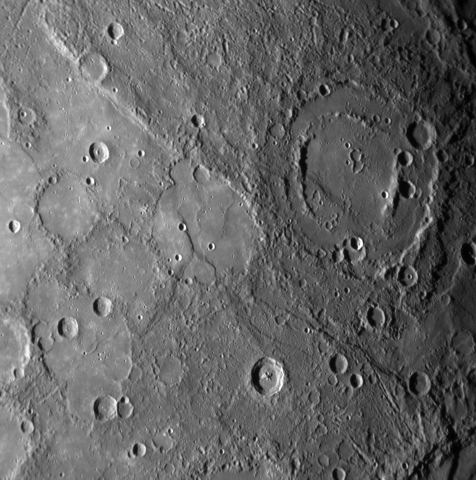 |
This is a file from the Wikimedia Commons. Information from its description page there is shown below.
Commons is a freely licensed media file repository. You can help.
|
Summary
| DescriptionMESSENGER EN0108828359M.png |
Shortly following MESSENGER’s closest approach to Mercury on January 14, 2008, the spacecraft’s Narrow Angle Camera (NAC) on the Mercury Dual Imaging System (MDIS) instrument acquired this image as part of a mosaic that covers much of the sunlit portion of the hemisphere not viewed by Mariner 10. Images such as this one can be read in terms of a sequence of geological events and provide insight into the relative timing of processes that have acted on Mercury's surface in the past.
The double-ringed crater pictured in the lower left of this image appears to be filled with smooth plains material, perhaps volcanic in nature. This crater was subsequently disrupted by the formation of a prominent scarp (cliff), the surface expression of a major crustal fault system, that runs alongside part of its northern rim and may have led to the uplift seen across a portion of the crater’s floor. A smaller crater in the lower right of the image has also been cut by the scarp, showing that the fault beneath the scarp was active after both of these craters had formed. The MESSENGER team is working to combine inferences about the timing of events gained from this image with similar information from the hundreds of other images acquired by MESSENGER to extend and refine the geological history of Mercury previously defined on the basis only of Mariner 10 images.
This MESSENGER image was taken from a distance of about 18,000 kilometers (11,000 miles) from the surface of Mercury, at 20:03 UTC, about 58 minutes after the closest approach point of the flyby. The region shown is about 500 kilometers (300 miles) across, and craters as small as 1 kilometer (0.6 mile) can be seen in this image.
Explanation page at:
|
| Date |
14 January 2008 |
| Source |
http://messenger.jhuapl.edu/gallery/sciencePhotos/pics/EN0108828359M.png |
| Author |
NASA/Johns Hopkins University Applied Physics Laboratory/Carnegie Institution of Washington |
Licensing
| Public domainPublic domainfalsefalse |
 |
This file is in the public domain because it was solely created by NASA. NASA copyright policy states that "NASA material is not protected by copyright unless noted". (See Template:PD-USGov, NASA copyright policy page or JPL Image Use Policy.) |
|
|
|
Warnings:
- Use of NASA logos, insignia and emblems are restricted per US law 14 CFR 1221.
- The NASA website hosts a large number of images from the Soviet/ Russian space agency, and other non-American space agencies. These are not necessarily in the public domain.
- Materials based on Hubble Space Telescope data may be copyrighted if they are not explicitly produced by the STScI. See also {{ PD-Hubble}} and {{ Cc-Hubble}}.
- The SOHO (ESA & NASA) joint project implies that all materials created by its probe are copyrighted and require permission for commercial non-educational use.
- Images featured on the Astronomy Picture of the Day (APOD) web site may be copyrighted.
|
File usage
The following pages on Schools Wikipedia link to this image (list may be incomplete):





